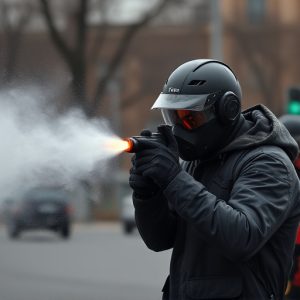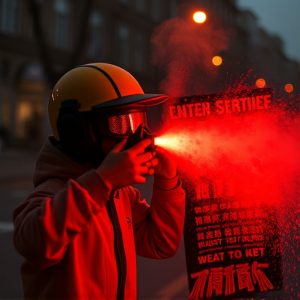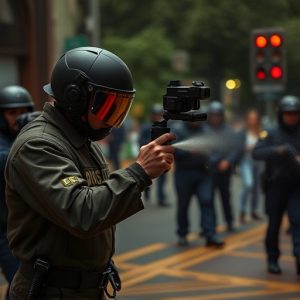Decoding Pepper Spray: Safety, Science, and Legal Implications for Self-Defense
Pepper spray, containing capsaicinoids like Oleoresin Capsicin (OC), is a non-lethal defense tool t…….
Pepper spray, containing capsaicinoids like Oleoresin Capsicin (OC), is a non-lethal defense tool that causes temporary vision loss but does not lead to permanent blindness. It works by causing intense irritation to the eyes, skin, and respiratory system, triggering a burning sensation that leads to lacrimation and a reflexive closing of the eyes. The effects can last from 15 to 45 minutes, disorienting the attacker and significantly reducing their combat effectiveness. While it is a potent deterrent, it is not designed to cause long-term harm; thus, concerns about whether pepper spray can blind you are unfounded in terms of permanent vision loss. Users should be aware of its capabilities and limitations, adhere to local laws regarding its use, and understand its role as a tool for self-defense rather than offense. Proper training is essential to ensure the safe and effective deployment of pepper spray.
Non-lethal defense options have become increasingly prominent in personal safety strategies, with pepper spray standing out as a widely used deterrent. This article delves into the intricacies of pepper spray, from its chemical makeup to its profound impact on an attacker’s sensory perception. Understanding how this defense mechanism works and its potential to temporarily impair vision is crucial for those considering it as part of their safety arsenal. We will explore the science behind pepper spray, assess its risks—including concerns like whether it can lead to temporary blindness—and navigate the legal landscape that governs its use. Additionally, we offer practical advice on the most effective ways to employ pepper spray in self-defense situations. This guide aims to provide a comprehensive overview of this non-lethal defense option and help readers make informed decisions about its role in their personal safety plans. Can pepper spray blind you? This article will shed light on this question and more.
Understanding Pepper Spray: Chemical Composition and Effects on Vision
Pepper spray, a commonly used non-lethal defense mechanism, is formulated with capsaicinoid compounds derived from chili peppers. The primary active component, Oleoresin Capsaicin (OC), is responsible for inducing a potent and irritating sensation upon contact with the eyes or mucous membranes. When discharged, the spray’s particles penetrate deeply into the eyes, causing immediate burning, intense pain, and a temporary loss of vision. This effect occurs because capsaicin targets the trigeminal nerves, which are responsible for sensory perception in the face, including the eyes. The effects can last from 15 to 45 minutes, providing ample time for law enforcement or individuals to subdue an assailant without causing permanent damage. It’s a critical aspect of its use that pepper spray does not blind a person permanently; it incapacitates by creating an intense discomfort that impairs vision temporarily. This distinction between temporary incapacitation and irreversible harm is what sets pepper spray as a non-lethal defense tool apart from other options, making it a preferred choice for self-defense and crowd control in various settings. Understanding the chemical composition of pepper spray and its effects on vision is crucial for anyone considering it as a personal safety measure, ensuring they are equipped with knowledge about both its efficacy and limitations.
The Science Behind Pepper Spray and Its Impact on Sensory Perception
Pepper spray, a non-lethal defense mechanism widely used by both law enforcement and civilians, is formulated with capsaicinoids derived from chili peppers. These compounds, when deployed, irritate the eyes, skin, and respiratory system of an attacker. The oleoresin capsicum in pepper spray binds to the pain receptors located in the mucous membranes, which include those in the eyes, nose, throat, and lungs. This interaction triggers a rapid release of neurotransmitters that mediate pain, resulting in an intense burning sensation and involuntary eye closing within seconds. The eyes’ ability to see is compromised as the lacrimal glands produce copious amounts of tears, attempting to flush out the irritant. This physiological response not only impairs vision but also significantly diminishes the attacker’s sensory perception, making them disoriented and less capable of effectively defending themselves. The effects can last from 30 minutes to an hour, providing a critical window of opportunity for escape or for law enforcement intervention. Understanding the science behind pepper spray is crucial for recognizing its effectiveness as a defensive tool and for knowing how it can temporarily incapacitate an assailant without causing permanent harm, addressing concerns such as “can pepper spray blind you,” which is a common inquiry regarding its use.
Evaluating the Risks: Can Pepper Spray Cause Temporary Blindness?
Pepper spray, a common non-lethal defense mechanism, is widely used for personal protection due to its effective deterrent properties. It contains an irritant, capsaicin, derived from chili peppers, which can cause intense eye and respiratory irritation upon contact. The question of whether pepper spray can temporarily blind a person arises from the severity of its effects on the sensory organs, particularly the eyes. While it does not cause permanent blindness, the compound in pepper spray can lead to a temporary loss of vision ranging from blurred vision to complete blindness for several minutes. This occurs because the capsaicin depletes the body’s stores of Adenosine Triphosphate (ATP), which is essential for proper cellular function, including vision. The effects are more pronounced in the eyes due to their high concentration of ATP and sensory neurons. When considering the use of pepper spray as a defense tool, it is crucial to evaluate not only its effectiveness against attackers but also to understand the potential risks involved, especially for individuals with pre-existing eye conditions or respiratory issues. Users should be aware that while pepper spray can effectively deter an assailant, it may cause significant discomfort and impairment temporarily, necessitating proper training and discretion in its use.
Legal Considerations and Regulations Governing the Use of Pepper Spray
When considering non-lethal defense options, pepper spray emerges as a widely used deterrent due to its effectiveness and relative legal acceptance in various jurisdictions. Pepper spray, also known as OC (oleoresin capsicum) spray, is a form of self-defense that temporarily impairs an attacker’s vision and ability to breathe by irritating the eyes, nose, and throat. Its use is governed by specific laws designed to balance personal safety with public order and individual rights. Legal considerations for pepper spray include restrictions on its strength, possession, and use. For instance, many regions set limits on the concentration of active ingredients in pepper sprays to prevent misuse or injury that could potentially lead to prolonged incapacitation. Additionally, regulations often dictate who can legally purchase, carry, and use pepper spray; for example, it is commonly permitted for self-defense by individuals who are not law enforcement officers. The legality of using pepper spray is also context-dependent, with varying laws determining its permissibility in different scenarios, such as in personal defense versus crowd control. It’s important for potential users to research and understand the specific laws applicable to their location, as the legal framework for pepper spray can vary significantly from one region to another. Contrary to some misconceptions, when used according to the law and within its intended scope, pepper spray is designed to incapacitate rather than cause permanent harm, addressing concerns such as whether it can permanently blind someone. Users should always adhere to legal guidelines to ensure their use of pepper spray aligns with safety standards and regulatory requirements.
Practical Use of Pepper Spray in Self-Defense: Tips and Best Practices
Pepper spray is a widely recognized non-lethal self-defense tool, effectively deterring attackers by causing irritation to the eyes and respiratory system. When considering pepper spray as a defense mechanism, it’s crucial to understand its practical use and how to deploy it effectively. Firstly, for optimal effectiveness, choose a spray that delivers a concentrated dose of oleoresin capsicin (pepper extract) within a defined range, ensuring it reaches the assailant’s eyes. Practice deploying the spray in environments similar to where you might use it, so you can react instinctively under stress. Aim high, towards the attacker’s face, as this will cause disorientation and buying you time to escape or seek help. It’s a common question whether pepper spray can permanently blind someone; while it does not have the potential to cause permanent blindness, the intense burning sensation and pain can be debilitating for several hours. Remember, the goal is self-defense, not long-term injury.
When acquiring and using pepper spray, adhere to local laws and regulations regarding its use and storage. Regularly test your spray according to the manufacturer’s instructions to ensure it’s in working condition. Additionally, consider taking a self-defense class that includes training with pepper spray; this hands-on experience can greatly enhance your proficiency. Always be aware of the wind conditions and potential for spray backlash, as this could compromise your safety. In the event of an attack, remember to yell for help if possible, as drawing attention can further deter the assailant and alert others to the situation. Understanding the limitations and proper use of pepper spray is essential for it to be a reliable component of your personal safety plan.


